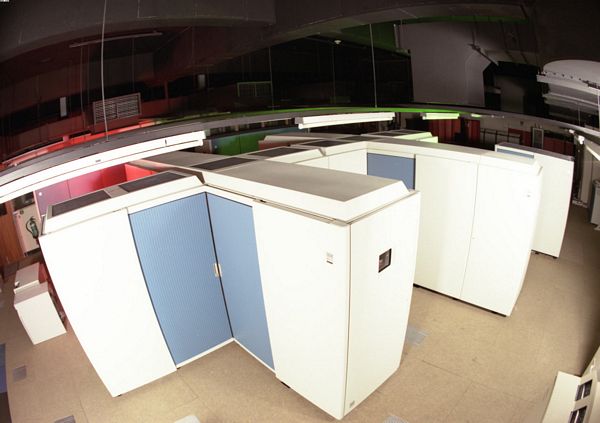

At the beginning of this period the mainframe services were provided on an IBM 3081 and an ICL Atlas10, with the IBM acting as a front end taking the interactive and communications workloads and batch work being handled mainly by the Atlas 10. The machines had 32 and 24 MBytes of memory respectively and 32 GBytes of shared disk space. The main operating systems were IBM's VM/CMS and MVS, and there were subsystems including PROFS for office automation, UTS for Unix terminal access. SLACBATCH was being introduced as an alternative to MVS for batch processing.
The services had about 2,000 users supported by all Boards of SERC, Nuclear Physics Board being much the largest user in terms of processing time, and there was a large community of PROFS users, initially from RAL and later from SERC's central office at Swindon. At peak times there were typically around 300 concurrent users logged into the interactive services, eventually growing to 400.
A charging regime for the use of these services was introduced in 1985 following a recommendation of an SERC Computing Review Working Party during the previous year. Separate charges were made for interactive and batch usage, and the entities charged were the Boards of SERC rather than individual users.
The first major change to the mainframe equipment came in 1988 when the two machines were replaced by a single IBM 3090-200E/1VF. This was a two-processor machine with 64 Mbytes of main memory and 128 Mbytes of expanded storage used for paging. The combined conventional processing power was about the same as that of the previous combination (around 30 mips) but the running costs were considerably lower. But the machine also had a vector processing unit which in principle could deliver 116 Mflops. Performance in practice depended very much on the nature of the code being executed, particularly the numbers and types of DO loops encountered, but speed increases of between two and five for such loops were common.

In 1989, as a result of a two-year (later extended to three) joint study agreement with IBM, the mainframe service was upgraded to a 3090/600E/6VF with six processors and six vector facilities. Overall, the computational power of this machine was a little less than that of the Atlas Centre's four processor Cray X-MP/48 supercomputer, but the IBM machine had larger memory (256 MB of main memory and 1GB of expanded storage). IBM's aim in the joint study was to develop partnerships with academic institutions specialising in numerically intensive computing techniques. Applications to exploit the facilities were sought from the academic community and an initial dozen projects spanning a wide range of science were selected. The remaining capacity on the machine was available to SERC users as before, but the charging regime that had been introduced in 1985 was dropped in favour of an arrangement whereby Boards of SERC maintained their current funding levels while having access to the increased capacity that had become available.
By the time the joint study agreement was completed in 1992 more cost effective methods of meeting the future 'mainframe' requirements were becoming available as technologies advanced. By 1993 the IBM 3090 had been reduced in capacity and three new scientific computing services were being introduced to take up the growing workload. The first two were based on Digital's new Alpha processor which had an advanced RISC super-scalar architecture. One was a DEC 7000 with three processors and 512 MB of memory running OpenVMS, each processor delivering on average about three times the performance of a single IBM 3090 processor. The other was a Unix service on a farm of five DEC 3000 Alpha machines, with aggregate power equivalent to about ten 3090 processors. The third service was a clone of a Central Simulation Facility (CSF) developed at CERN, based on six HP9000 model 735 RISC workstations, each processor being equivalent to about four 3090s.
To complete the picture of moves away from an IBM mainframe environment, 1994 saw the start of a development of a new office system for RAL and Daresbury Laboratory which would replace IBM's PROFS and would be based on distributed servers supporting PC and Mac clients.
Thus by late 1994 the non-supercomputing processing power for scientific computing was more than twenty times that available in 1984. Further changes were to come following a review for the Particle Physics Committee of the Particle Physics and Astronomy Research Council of its future requirements for central computing which set the scene for tailored services at RAL with greater capacity, optimised use of the data storage facilities and requiring less staff support effort.